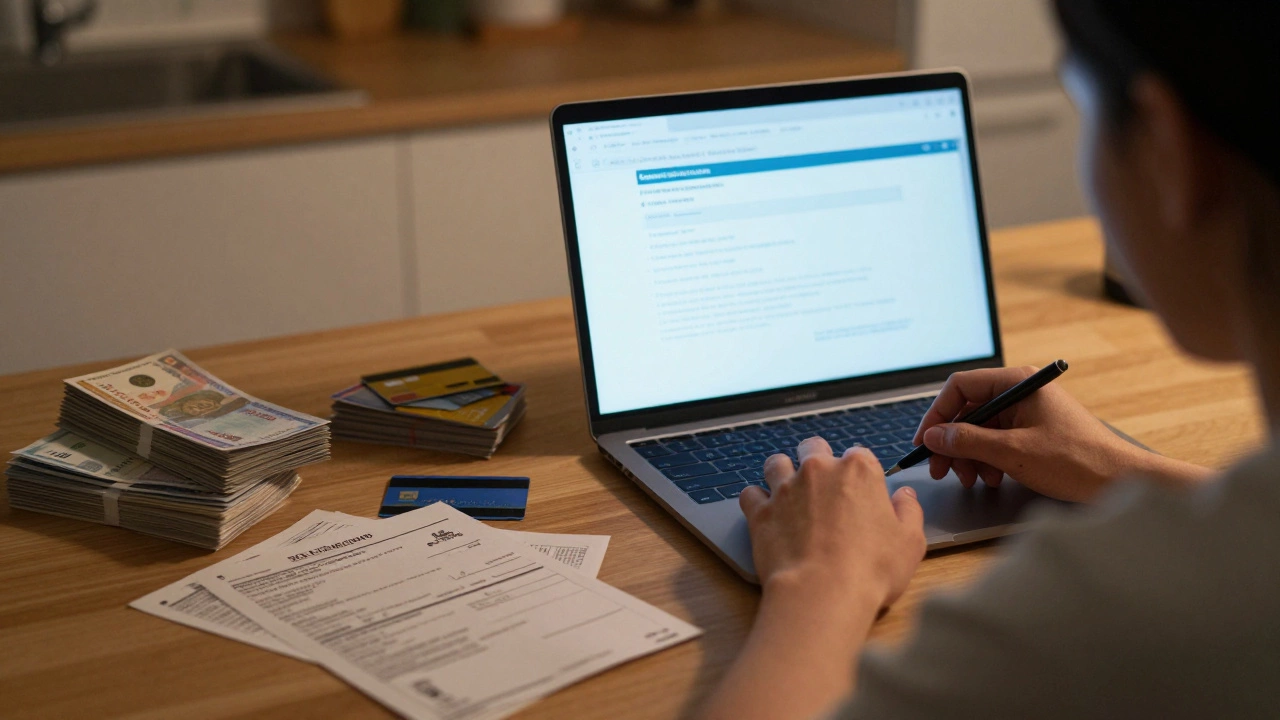So, you've heard about this thing called the 40 40 20 budget, and you're probably wondering what the fuss is all about. It's all about dividing your monthly income into three categories: 40% for living expenses, another 40% for savings or paying off debt, and the last 20% for whatever you feel like spending on. Sounds simple, right? It actually is! And that's why it works for a lot of people.
Think of it as a method to keep your finances in check without getting lost in a sea of spreadsheets. You know how some budgets seem to need a degree in finance? Not this one. It's like sticking to a simple rule of thumb where most of your money goes into essentials like rent, groceries, and bills.
The next chunk is all about setting yourself up for the future. Whether that's piling money into a savings account, investing, or knocking down your debt, it’s crucial for long-term peace of mind. You’ll feel way less stressed knowing you’re prepared for what's next.
- Understanding the 40 40 20 Split
- Benefits of the 40 40 20 Budget
- Setting Up Your Income Streams
- Tips for Sticking to Your Budget
- Adjusting the Budget for Your Needs
- Common Mistakes to Avoid
Understanding the 40 40 20 Split
The 40 40 20 budget is designed to simplify how you manage your money by neatly dividing it into three main chunks. So, let’s break it down.
40% of your income goes to essential expenses. Think of this as the stuff you really can't live without: rent or mortgage payments, utility bills, groceries, and maybe that pesky phone bill. You know, the basics that keep your everyday life ticking along smoothly.
Now, the second 40% is all about planning ahead. This portion can be split between savings and debt repayment. If you're paying off a student loan or a mortgage, this is where it comes in. Alternatively, you can channel it into savings for a bigger goal—like that trip to Japan you’ve been dreaming about or beefing up your emergency fund.
The last 20% is your fun money or discretionary spending. It's the guilt-free cash you can spend on things like eating out, new clothes, or a night out with friends. It gives you the wiggle room to enjoy life without throwing your entire budget off track.
Here's a quick look at how your budget might shape up:
| Category | Percentage | Example Spend |
|---|---|---|
| Essentials | 40% | Rent, utilities |
| Savings/Debt | 40% | Savings, loans |
| Discretionary | 20% | Entertainment, dining out |
This budget method is straightforward but super effective for gaining control over your personal finances. It ensures you're covering your must-haves, securing your money future, and still having a life!
Benefits of the 40 40 20 Budget
Using the 40 40 20 budget isn't just about putting numbers into categories. It's about giving your finances some structure without making your head spin. One of the best things about this budget is its simplicity. You don't need fancy apps or a degree in finance to figure it out. It breaks down your spending into three main areas, making it easier to track where your money is going.
This budgeting method helps with discipline too. When you have clear rules — 40% for essentials, another 40% for savings or debt, and 20% for fun stuff — you’re less likely to stray. It’s like telling yourself what your future priorities are every time you get paid. This makes saving for things you care about, like a new car or vacation, a lot easier to manage.
The flexibility it offers is crucial. Not everyone's life looks the same, right? The 40 40 20 rule can be adjusted if your situation changes. Maybe you're in between jobs and need to tweak those percentages for a while. It’s adaptable, so you can have peace of mind even if things aren't going perfectly.
- Encourages Savings: By automatically setting aside 40% for savings or debt, it ensures you're looking out for your future self.
- Reduces Financial Stress: Knowing exactly what’s for bills and what's for fun can lower anxiety about overspending.
- Promotes Wise Spending: By limiting discretionary spending to 20%, you force yourself to make smarter choices about how you treat yourself.
- Room for Adjustment: Life changes, and so can your budget. If your expenses grow or shrink, the rule can flex to accommodate those shifts.
Studies have shown that having a budget, especially one that's easy to follow like the 40 40 20 budget, can increase your savings and reduce debt more effectively than flying blind with your finances. In a world where many struggle to make ends meet, having a simple, yet effective way to manage your money can be a game-changer.
Setting Up Your Income Streams
Before you can start using the 40 40 20 budget, you need to get a clear picture of your income. It's not just about your main paycheck. Think bigger! There might be extra cash coming in from side gigs, rental income, or even passive income from investments.
The first step? Gather all the details of your income sources. Make a list of your monthly income from each source. Try using a simple spreadsheet or an app to keep things organized. Don't forget to include anything extra like bonuses or freelance work!
"Budgeting isn't about restricting yourself; it's about making your money work for you," says Dave Ramsey, a well-known personal finance expert.
Got multiple sources? Awesome! You're already ahead. Diversifying where your money comes from can offer some stability. Imagine what happens if one source suddenly dries up—you've got others to fall back on. That’s a key advantage.
If you're looking to add more streams, here are a few ideas:
- Take advantage of your skills by freelancing or consulting. There’s a massive demand for everything from writing to graphic design.
- Consider renting out a room through platforms like Airbnb. It's a great way to make your property earn money.
- Invest in dividend stocks or an income-generating portfolio through retirement accounts.
Setting up robust income streams isn’t just a smart move. It’s necessary for securing financial freedom and getting the most out of the 40 40 20 rule. So make sure to diversify and monitor your income regularly.

Tips for Sticking to Your Budget
Alright, you're sold on the 40 40 20 rule, but how do you actually stick with it? It's all about making the budget feel as natural as brushing your teeth. You know, something you just do without overthinking it.
First up, track your expenses. It might sound a bit old school, but writing down what you spend can be a real eye-opener. You can use apps on your smartphone to make it a bit more exciting and less tedious. The more aware you are, the easier it gets to stay on track.
- Set reminders and alerts: Keep your budgeting goals at the front of your mind. Calendar reminders or app notifications can nudge you gently if you're veering off course.
- Automate savings and bill payments: By taking yourself out of the equation, you won't be tempted to 'accidentally' use funds meant for savings. Automation can be a game-changer here.
- Have a budget buddy: This is like a fitness buddy but for finances. Share your progress and setbacks with someone who can help hold you accountable. Ideally, choose someone who's also trying to master the 40 40 20 budget.
Also, keep an eye on your discretionary spending. It's that 20% that can cause hiccups. Maybe it's those impulse buys or that extra streaming service you never use. Find out what's leaking your cash and plug those gaps.
A trick in the budgeting world is the 24-hour rule. Before buying something you don’t really need, wait a day. You'll be surprised how many times you'll change your mind once the initial excitement wears off.
Remember, no budget is perfect from the get-go. Tweak things as you go along. Maybe the initial percentages need some adjustment. Personal finances should reflect personal needs, so don't be afraid to customize.
Adjusting the Budget for Your Needs
Alright, so you've got the basic 40 40 20 budget setup, but here's the deal—it might need some tweaking to fit your unique situation. This isn't some one-size-fits-all rule. Your financial needs will shift over time, and that’s totally normal. Let’s see how you can make this budget work for you.
Firstly, personal finance is personal. A young professional fresh out of uni will likely have a different money focus compared to someone who's just had a kid. So, don’t be afraid to give your budget a bit of a makeover. It's all about matching your money management to your life goals.
If you’re in a spot where your living costs are crazy high—like if you're in a big city—consider adjusting the percentages. Maybe you go for 50% essentials, 30% savings, and 20% fun spending. Just remember, the aim is to still increase savings when those fixed costs aren't eating up your budget.
Same goes if you find yourself with more wiggle room than you'd like. Maybe you’re knocking out those debts faster than your favorite takeout disappears. Pump up the savings portion to build up some killer savings or an emergency fund.
And hey, life throws curveballs. If something unexpected comes up, you can temporarily tweak your percentages. If there’s a shiny opportunity for a new skill or investment, you might dip into that 20% discretionary pot for a bit.
Budgeting is about balance, and it's okay if it doesn’t stay static. Look at where you are financially every couple of months and adjust those numbers as needed. It's like fine-tuning a guitar until you get the perfect sound.
Keen to see how this works? Imagine you’re planning a wedding. For about a year, you might adjust your budget to 30% living, 40% wedding costs, and 30% saving for a house. By setting clear goals and timelines, you avoid budget chaos.
Play around, track your spending, and most importantly, keep it realistic and honest. It’s all about making sure you’re covered today, tomorrow, and for those surprise curveballs life loves to pitch our way.
Common Mistakes to Avoid
Diving into the 40 40 20 budget can be exciting, but it's easy to slip up if you're not careful. One of the most common goofs is not keeping track of where you actually spend your cash. You might think you know where your money goes, but without some level of tracking, it's easy to blow past your limits, especially the discretionary 20%.
Another mistake people often make is underestimating their living expenses. If you find that your essential expenses are more than 40%, it might be time to re-evaluate or adjust your budget categories. Maybe your rent is too high, or you're spending a bit too much on those frequent grocery trips. Either way, if it doesn't fit, your budget needs some tweaks.
Some folks get overly ambitious with savings and debt repayments and cut too much from their personal spending. This sounds great on paper, but in reality, it can lead to burnout. You still need to enjoy life, right? The idea isn't to live like a monk but to create a balance that works for you.
Not planning for irregular expenses is another pitfall. Let's say the car breaks down or you need to buy gifts during the holiday season. These aren't monthly expenses, but they can bust your budget if you're not prepared. Stash a little extra away each month for these surprises so they don't knock you off course.
Finally, always failing to revise your budget when life changes is a missed opportunity. Got a raise? Changed jobs? Had a baby? Your budget should reflect these changes. As your life evolves, your personal finance plan should too. Keeping it flexible makes it a living tool that supports you, not a static rulebook that's hard to follow.









